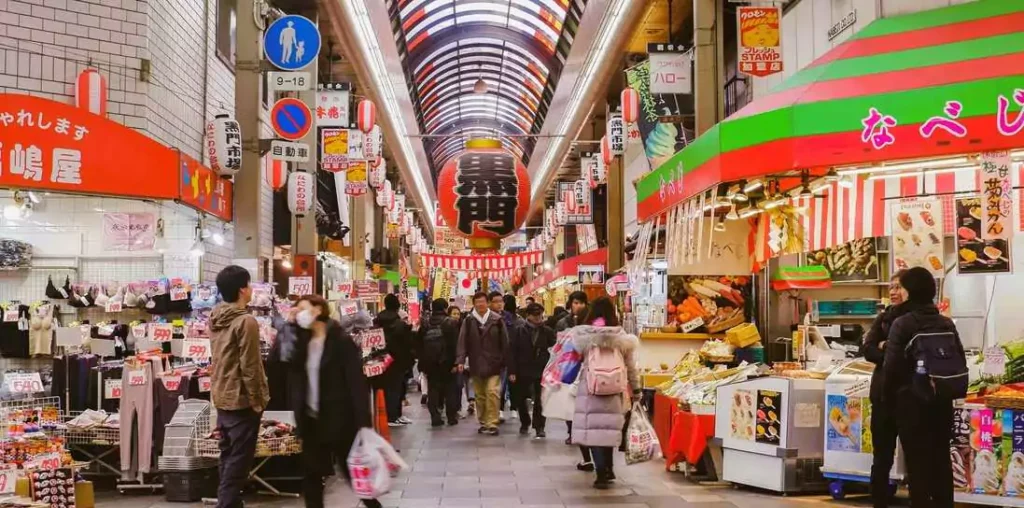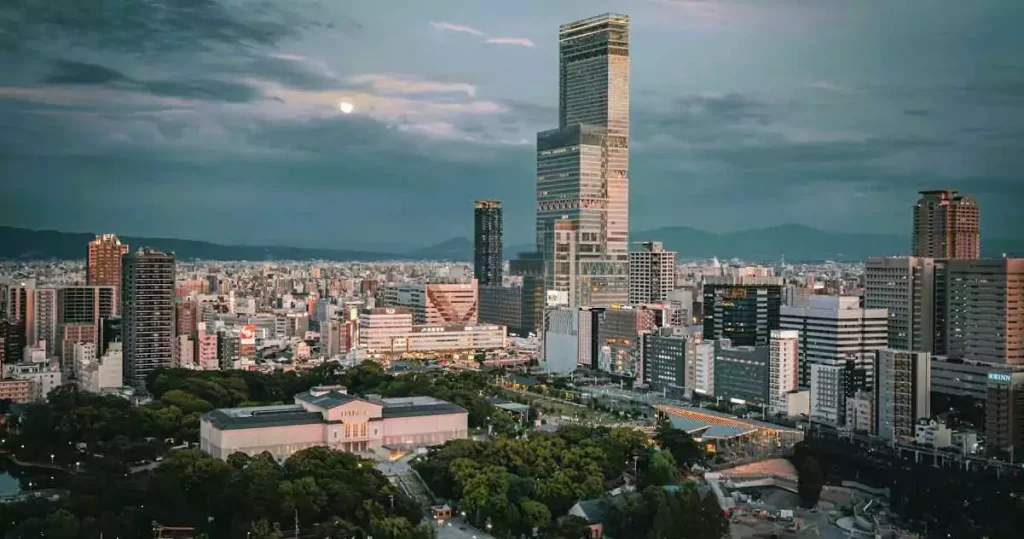Why Osaka is Perfect for Senior Travelers?
Welcome to Osaka, Japan’s vibrant heart of the Kansai region, where tradition meets modernity in a delightful blend that’s perfect for senior travelers. Known as the “Nation’s Kitchen,” Osaka offers a feast for the senses—culinary delights, historical treasures, and serene natural escapes—all wrapped in the warm hospitality of its friendly locals.
For seniors seeking a balance of adventure and relaxation, Osaka is an ideal destination. Its efficient public transportation, safe streets, and abundance of senior-friendly amenities make it easy to explore at a comfortable pace. Whether you’re traveling solo, with a partner, or alongside family, this five-day itinerary is designed to ensure a memorable, stress-free experience tailored to your needs. Let’s dive into a journey that celebrates Osaka’s charm while keeping comfort and accessibility front and center.
Day-by-Day Osaka Itinerary for Senior Citizens
Day 1: Arrival and Settling In
After your journey to Osaka, likely arriving at Kansai International Airport (KIX), the first day is all about easing into your adventure. From the airport, hop on the Nankai Airport Express or JR Haruka train to central Osaka—both are comfortable options with ample seating and space for luggage. Aim to arrive at your hotel by mid-afternoon to give yourself time to unwind.
Senior-Friendly Hotel Recommendations:
– Swissotel Nankai Osaka: Located above Namba Station, this hotel offers spacious rooms, plush bedding, and easy access to transportation and dining. Its central location minimizes walking, and the staff are known for their attentive service—perfect for seniors needing a little extra assistance.
– Hotel Granvia Osaka: Situated atop JR Osaka Station, this hotel combines convenience with comfort. With elevators everywhere and a variety of on-site restaurants, it’s a great base for exploring the city without overexertion.
– LIBER Hotel Osaka: In the quieter Osaka Bay area, this modern hotel features large rooms, a relaxing garden terrace, and proximity to Universal Studios Japan (if you’re feeling adventurous later). It’s a peaceful retreat with senior-friendly amenities like wide hallways and accessible bathrooms.
Once settled, take a gentle evening stroll to stretch your legs. If you’re staying near Namba, wander to Dotonbori Canal—just a short distance from Swissotel. The dazzling lights and lively atmosphere are captivating, but you don’t need to dive into the crowds. Find a bench along the canal, enjoy the ambiance, and perhaps grab a light snack like takoyaki (octopus balls) from a nearby stall with seating. Keep it low-key—tomorrow’s adventures await!
Tip: Request a room on a lower floor if stairs are a concern, and ask the hotel for a kettle and tea to relax after your travels.
Day 2: Cultural Exploration
Day two is all about immersing yourself in Osaka’s rich history and traditions at a leisurely pace. Start with a hearty breakfast at your hotel—most offer buffet options with both Japanese and Western dishes to suit your tastes.
Morning: Osaka Castle
Head to Osaka Castle, a must-see landmark that’s surprisingly accessible for 99. Take the subway (e.g., the Tanimachi Line from Namba to Tanimachi 4-chome Station) or a short taxi ride. The castle grounds are flat and spacious, with paved paths leading to the main tower. Elevators are available to reach the observation deck on the 8th floor, offering panoramic views of the city without the strain of climbing stairs. Spend an hour or two exploring the museum inside, which details the castle’s history with English signage, and enjoy the tranquil Nishinomaru Garden nearby—perfect for a restful break on a bench under cherry trees (especially lovely in spring).

Afternoon: Tea Ceremony and Museums
After a light lunch (try a nearby café like Café Terrace GARB for simple, senior-friendly meals), join a traditional tea ceremony at a venue like Maikoya Osaka in Shinsaibashi. This cultural experience is seated (often with cushions or chairs for comfort), and the staff guides you through the ritual of preparing and sipping matcha. It’s a calm, reflective activity that’s easy on the body and soul.
Next, visit the Osaka Museum of History, a short walk or taxi ride from the castle. With ramps, elevators, and plenty of seating, it’s senior-friendly and offers fascinating exhibits on Osaka’s past. Focus on the upper floors for views of the castle and a chance to sit while soaking in the displays.
Evening: Relax
Return to your hotel for a restful evening. If you’re up for it, dine at an on-site restaurant—hotels like Granvia offer Japanese set meals (kaiseki) that are flavorful yet gentle on the stomach.
Tip: Wear comfortable shoes for the castle grounds, and bring a small cushion if kneeling during the tea ceremony might be uncomfortable.
Related: The 15 Best Slow-Paced Tours of Japan for Seniors
Day 3: Scenic Views and Leisure
Today is about enjoying Osaka’s natural beauty and a touch of leisure—no rush, just relaxation. Pack a light jacket and a water bottle, and let’s explore.
Morning: Expo ’70 Commemorative Park
Take the Midosuji Line subway to Senri-Chuo Station, then a short bus ride to Expo ’70 Commemorative Park. This sprawling green space is flat and dotted with benches, making it ideal for a gentle stroll. Admire the iconic Tower of the Sun sculpture and the seasonal blooms—cherry blossoms in spring or fiery maples in autumn. Bring a picnic (or grab something from the park’s café) and enjoy a quiet morning surrounded by nature. Wheelchair rentals are available if mobility is a concern.

Afternoon: Aqua-Liner River Cruise
Head back to central Osaka for a relaxing Aqua-Liner River Cruise along the Yodo River. Board at the Osakajo Pier near Osaka Castle (a short taxi ride from the subway). This 60-minute cruise offers cushioned seating and stunning views of landmarks like the castle and Nakanoshima Park—no walking required. The gentle pace and narrated tour (with some English) make it a delightful way to see the city.
Evening: Dinner with a View
End the day at the Umeda Sky Building’s Sky Lounge Stardust, accessible via the Kita subway lines. Elevators take you to this rooftop bar with panoramic city views. Sip a mocktail or tea and enjoy a light meal—think sandwiches or small plates—while watching the sunset. It’s a serene cap to a peaceful day.
Tip: Book the river cruise in advance through your hotel concierge to secure a spot and avoid queues.
Day 4: Culinary Delights
Osaka’s nickname, “Nation’s Kitchen,” shines today as we explore its food scene in a senior-friendly way. Wear stretchy pants—you’ll want room for these treats!
Morning: Kuromon Ichiba Market
Start at Kuromon Ichiba Market, a short subway ride to Nippombashi Station. This covered market is flat and easy to navigate, with vendors offering bite-sized samples of fresh seafood, grilled skewers, and sweets. Try kushikatsu (deep-fried skewers) or a small portion of okonomiyaki (savory pancake) from stalls with seating. Pace yourself—small tastes keep it manageable and fun.

Afternoon: Senior-Friendly Food Tour
Join a guided Osaka Night Food Tour (bookable via sites like KKday or Viator), tailored for small groups and slower paces. These tours often include stops at Dotonbori and quieter eateries, with sit-down options to sample local specialties like takoyaki and kitsune udon (noodles with tofu). Guides ensure dietary needs are met, and the walking is minimal with breaks.
Evening: Dinner at a Traditional Izakaya
Dine at Izumoya near Shinsaibashi, a cozy izakaya with English menus and comfortable seating. Order a set meal with grilled fish, rice, and miso soup—flavorful yet light. The staff are patient and welcoming, making it a stress-free experience.
Tip: Inform tour guides of any dietary restrictions ahead of time, and carry a small snack in case you need a quick energy boost.
Related: Kyoto must-see: Top 14 Things to Do in Kyoto
Day 5: Shopping and Souvenirs
Your final day is for picking up mementos and enjoying Osaka’s accessible shopping scene. Keep it relaxed and fun.
Morning: Shinsaibashi-Suji Shopping Street
Take the subway to Shinsaibashi Station and explore Shinsaibashi-Suji, a covered arcade that’s flat and easy to walk. Browse stores like Daiso for affordable trinkets or Tokyu Hands for unique Japanese crafts. Rest on benches along the way, and pick up souvenirs like folding fans, matcha sweets, or silk scarves—light and easy to pack.
Afternoon: Tennoji and Abeno Harukas
Head to Tennoji Station (via the Midosuji Line) and visit Abeno Harukas, Japan’s tallest building. The 16th-floor observation deck is free and accessible by elevator, offering stunning views. The lower floors house department stores with high-quality souvenirs—think lacquerware or ceramics. Nearby, Tennoji Park offers a quiet spot to rest if needed.

Evening: Farewell Dinner
Return to your hotel and enjoy a farewell meal at a nearby restaurant. If you’re at Swissotel, try Minami for a refined Japanese dinner with attentive service. Reflect on your trip over a warm cup of tea.
Tip: Use a lightweight shopping bag with wheels to carry purchases comfortably.
Practical Tips for Senior Travelers
Mobility and Accessibility
Osaka’s public transportation is a senior’s dream—clean, punctual, and equipped with elevators and escalators at major stations like Namba, Umeda, and Tennoji. Purchase an ICOCA card, a rechargeable pass for trains, subways, and buses, to avoid fumbling with tickets. Priority seating is reserved for seniors, and staff are quick to assist. For longer distances, taxis are affordable and reliable—look for those with English-speaking drivers via apps like JapanTaxi. Venues like Osaka Castle and Abeno Harukas offer ramps, elevators, and wheelchairs, ensuring you can explore with ease.
Health and Safety
Japan is one of the safest countries for travelers, with low crime rates and clean streets. Still, consider travel insurance with medical coverage—companies like Allianz or World Nomads offer senior-friendly plans. Osaka has excellent medical facilities, such as Osaka University Hospital, and pharmacies (look for the green cross sign) stock over-the-counter remedies. Pack medications in carry-on luggage, stay hydrated, and rest when needed—hotels often provide slippers and robes for ultimate comfort.
Language and Communication
While English isn’t widely spoken, Osaka’s tourist areas have signage and menus in English, and locals are eager to help. Download Google Translate for offline use, and carry a phrase card with essentials like:
– “”Hello”—Konnichiwa
– “Thank you”—Arigatou”
– “Where is the bathroom?” – Toire wa doko desu ka?
– “I need help”—Tasukete ”kudasai
Pointing and smiling goes a long way, and hotel staff can assist with bookings or directions.
What is the best month to go to Osaka?
The best month to visit Osaka depends on your preferences as a senior traveler, but for a comfortable and enjoyable experience, October stands out as an ideal choice. Here’s why, along with some alternatives to consider:
Why October is the Best Month
– Weather: October brings mild, pleasant temperatures averaging 15–23°C (59–73°F), perfect for strolls without the strain of extreme heat or cold. Humidity drops compared to summer, making it easier to stay comfortable outdoors.
– Scenery: Early autumn colors begin to emerge, especially in places like Expo ’70 Commemorative Park and Osaka Castle’s Nishinomaru Garden. While not as vivid as November’s peak foliage, the subtle hues add charm without the larger crowds.
– Crowds: October falls between summer vacation and the late-autumn tourist rush, offering a quieter experience at attractions—less waiting and more relaxation.
– Events: The Osaka Classic Car Show and smaller local festivals often occur, providing a gentle cultural experience you can enjoy at your own pace.
Other Great Months
– April: Spring shines with cherry blossoms (peak bloom around early April), mild weather (12–20°C or 54–68°F), and a festive atmosphere. It’s busier than October, but the flat, accessible parks like Tennoji make blossom viewing manageable. Bring a light jacket for cooler evenings.
– May: Late spring offers warm but not oppressive temperatures (15–25°C or 59–77°F) and fewer crowds than cherry blossom season. It’s a sweet spot for garden visits and river cruises before summer humidity kicks in.
– November: For vibrant autumn foliage, November (15–20°C or 59–68°F) is stunning, though cooler and more crowded. The crisp air is invigorating, and heated indoor options like museums balance outdoor time.
Months to Avoid
– July–August: Summer brings heat (30–35°C or 86–95°F) and high humidity, which can be exhausting for seniors, especially with more walking.
– January–February: Winter is chilly (2–10°C or 36–50°F) and occasionally windy, potentially uncomfortable for those sensitive to cold, though crowds are thin.
Conclusion: A Trip to Cherish
Osaka welcomes senior travelers with open arms, offering a perfect mix of culture, cuisine, and calm. This five-day itinerary ensures you experience its highlights at a pace that suits you, with plenty of time to rest and savor each moment. From the majestic Osaka Castle to the soothing river cruises and delectable takoyaki, you’ll leave with memories—and maybe a few souvenirs—to treasure. So pack your bags, bring your curiosity, and let Osaka show you why it’s a senior traveler’s paradise. Safe travels!

